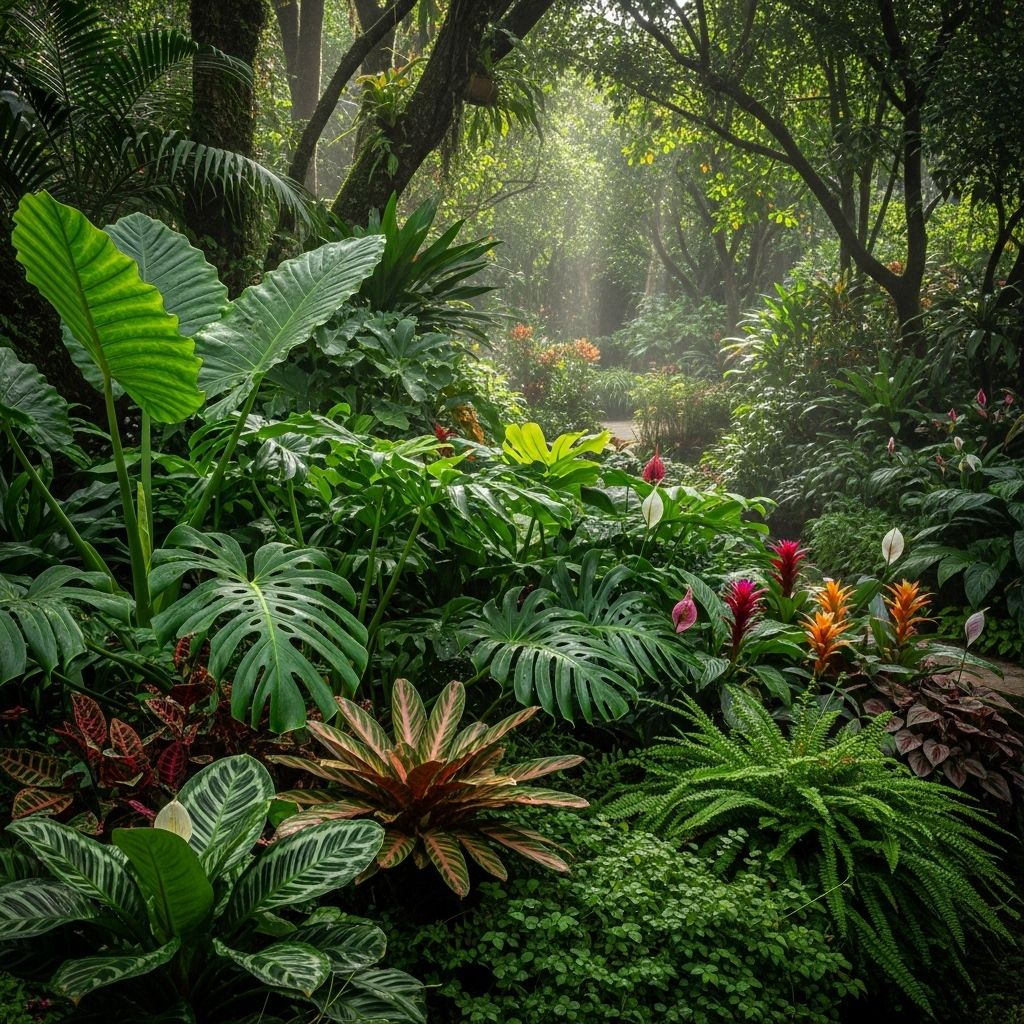21 Tropical Shade Plants: Lush, Exotic Choices for Low-Light Gardens
Unleash exotic colors and dramatic leaves in dim areas for a vibrant backyard retreat.

Image: HearthJunction Design Team
21 Tropical Plants That Grow Well in the Shade
Dreaming of a lush, exotic garden but your yard is shaded by trees or buildings? Many iconic tropical plants naturally thrive in the dappled light of rainforest canopies. These plants offer an explosion of color, texture, and drama—even in areas with limited sunlight. In this guide, you’ll discover 21 tropical plants that love shade, plus expert tips for creating a thriving, low-light paradise.
Why Choose Tropical Shade Plants?
In their native environments, many tropical plants grow beneath tall trees, adapting to filtered sunlight and high humidity. With their broad leaves, vibrant blooms, and resilient nature, they’re perfect for brightening up shadowy corners or under-canopy spaces. A tropical shade garden delivers:
- Striking visual contrast with bold foliage and blooms
- Greater biodiversity and habitat for pollinators
- Low-maintenance beauty for difficult garden sites
Understanding Shade: Full Shade vs. Partial Shade
Before selecting your plants, it’s crucial to understand garden light levels:
- Full Shade: Four hours or less of direct sun daily, often under dense trees. Plants here get mostly dappled or indirect light. Most low-growing forest-floor species thrive in these conditions.
- Partial Shade: Four to six hours of sun daily, ideally during the cooler morning or late afternoon hours.
Note: All plants need some light to photosynthesize. While tropical shade plants tolerate low light, complete darkness isn’t suitable for any species.
21 Tropical Shade-Loving Plants
Create your own jungle escape with these showstopping plants, many of which originated in rainforest understories. Each offers unique foliage, flowers, or growth habits to bring your shade garden to life.
1. Impatiens (Impatiens walleriana)
- Sun Requirements: Partial to full shade
- Height: 6-24 inches
- Zones: USDA 10-11
The classic shade annual! Impatiens are beloved for their endless color options and ability to quickly fill containers, borders, and beds. Plant 8-12 inches apart for bushy, low growth. For sunnier spots, try New Guinea impatiens (Impatiens hawkeri), which tolerate more sun but still appreciate shade.
2. Caladium (Caladium bicolor)
- Sun Requirements: Shade to filtered light
- Height: 12-30 inches
Caladiums dazzle with heart-shaped leaves splashed in pink, red, green, and white. Their dramatic foliage makes them ideal for mass plantings or as thrilling focal points in containers. They crave rich, moist soil and high humidity.
3. Begonia (Begonia spp.)
- Sun Requirements: Partial to full shade
- Height: Varies by type
From the metallic-leafed rex begonias to trailing tuberous varieties, begonias bring stunning leaves and long-lasting blooms. They’re perfect for porch planters and garden beds alike.
4. Peace Lily (Spathiphyllum spp.)
- Sun Requirements: Low to medium light
- Height: 1-3 feet
Famous as an easy-care houseplant, peace lilies also thrive outdoors in the shade in warm climates. Their glossy leaves and elegant white blooms add tranquility and structure.
5. Anthurium (Anthurium andraeanum)
- Sun Requirements: Indirect bright to low light
- Height: 1-2 feet
Anthuriums offer heart-shaped leaves and bold, waxy red or pink flowers. They’re especially prized for adding a pop of color in the shade garden or as tropical houseplants.
6. Hostas (Hosta spp.)
- Sun Requirements: Full to partial shade
- Height: 6-36 inches
While not strictly tropical, hostas bring a bold, leafy look reminiscent of a rainforest floor. Choose varieties with variegated foliage for extra visual interest.
7. Ferns
- Sun Requirements: Full to partial shade
- Height: Varies by species
Native to forest understories, ferns such as Boston, maidenhair, and bird’s nest add lush texture and thrive in shaded, moist environments.
8. African Violet (Saintpaulia spp.)
- Sun Requirements: Low to medium light
- Height: 6-12 inches
Petite and flowering, African violets brighten up shaded containers or indoor planters with fuzzy leaves and blooms in violet, white, and pink.
9. Bromeliads (Bromeliaceae family)
- Sun Requirements: Indirect light, shade-tolerant types available
- Height: 6-24 inches
These tropical epiphytes boast rosettes of colorful foliage and unique, long-lasting flowers. Many species love shaded garden beds or can be mounted on trees.
10. Philodendron (Philodendron spp.)
- Sun Requirements: Low to medium indirect light
- Height: Varies widely
Famous for their adaptability and bold, dramatic leaves, philodendrons are a staple in both indoor and outdoor shade gardens.
11. Alocasia (Alocasia spp.)
- Sun Requirements: Bright, indirect light
- Height: 2-6 feet
Known as “Elephant Ear,” alocasias display huge, arrow-shaped leaves. They thrive in partial to full shade with consistently moist soil and high humidity.
12. Colocasia (Colocasia esculenta)
- Sun Requirements: Partial shade, can tolerate full sun with moisture
- Height: 3-6 feet
Another “Elephant Ear” type, colocasia has even larger, shield-like leaves for a lush, jungle effect—perfect for pond edges or containers.
13. Ginger (Zingiberaceae family)
- Sun Requirements: Filtered light to partial shade
- Height: 2-6 feet
Ornamental gingers boast bold foliage and bright, exotic blooms. Plant in rich, consistently moist soils and protect from direct afternoon sun.
14. Taro (Colocasia antiquorum)
- Sun Requirements: Shade to partial shade
- Height: 3-6 feet
Taro brings a tropical look to water gardens or damp, shady soil, with lush leaves atop thick stems.
15. Cast Iron Plant (Aspidistra elatior)
- Sun Requirements: Full to deep shade
- Height: 2 feet
True to its name, this plant is nearly indestructible—a reliable choice for deep shade under trees or in containers where little else grows.
16. Japanese Aralia (Fatsia japonica)
- Sun Requirements: Full to partial shade
- Height: 4-8 feet
Large, glossy, palmate leaves create a bold backdrop in shade gardens. Aralia tolerates cold better than most tropical plants.
17. Hardy Banana (Musa basjoo)
- Sun Requirements: Shade to partial sun
- Height: Up to 12 feet
This banana species is more cold-tolerant and can thrive in shaded, protected spots, adding instant tropical flair.
18. Ti Plant (Cordyline fruticosa)
- Sun Requirements: Bright, indirect light to partial shade
- Height: 3-10 feet
Ti plants feature strappy, reddish-purple leaves and thrive in humid, sheltered garden beds or as bold container specimens.
19. Dumb Cane (Dieffenbachia spp.)
- Sun Requirements: Low to medium light
- Height: 3-5 feet
Dieffenbachia sports boldly patterned leaves and tolerates low-light indoor and outdoor conditions, but keep away from children and pets, as all parts are toxic if eaten.
20. Prayer Plant (Maranta leuconeura)
- Sun Requirements: Indirect light, shade
- Height: 6-12 inches
Striking for their unique leaf movement and intricate patterns, prayer plants excel in moist, shaded spots as groundcover or houseplants.
21. Sensitive Plant (Mimosa pudica)
- Sun Requirements: Full sun to part shade
- Height: 12-20 inches
- Zones: Perennial in the tropics, annual elsewhere
This fascinating plant features fern-like leaves that fold up when touched or at night. It grows well in containers or garden beds, adding interactive fun and delicate, globe-shaped blooms.
Designing Your Tropical Shade Garden: Expert Tips
- Mix textures: Combine large-leafed plants (Alocasia, Caladium) with fine-textured ferns or grasses for depth and drama.
- Layer heights: Tall bananas and aralias in the back, mid-sized philodendrons and begonias at center, low impatiens or prayer plants up front.
- Vary foliage color: Use variegated, chartreuse, or deep purple leaves to break up green and add year-round appeal.
- Embrace containers: Portability lets you move sun-sensitive species, experiment with new combinations, and adjust for winter protection.
- Keep soil moist: Most tropicals crave humus-rich, well-draining soil that retains moisture but never gets soggy.
Troubleshooting: Shade Garden Challenges
- Pale or yellowing leaves: Usually signals insufficient light. Move plants to brighter shade or prune overhead branches to allow more dappled sunlight.
- Stunted growth/lack of flowers: Overly deep shade or nutrient-poor soil may be to blame. Fertilize with an organic fertilizer and check your shade levels.
- Pest pressure: Humid, low-light environments can harbor slugs, snails, and fungal diseases. Maintain airflow, avoid waterlogging, and remove debris.
A Quick Comparison: Full Shade vs. Partial Shade Plants
| Plant Type | Shade Tolerance | Ideal Uses |
|---|---|---|
| Impatiens, Hostas, Ferns | Full shade | Forest floors, under trees, deep garden beds |
| Caladium, Ti Plant, Begonia | Partial to full shade | Borders, containers, accent plantings |
| Anthurium, Ginger, Dieffenbachia | Bright indirect to low light | Indoor/outdoor, patio pots, sheltered spots |
Frequently Asked Questions (FAQs)
Q: What does ‘full shade’ mean for tropical plants?
A: Full shade means receiving less than four hours of direct sunlight per day, typically with only dappled or indirect light, such as beneath thick tree canopies.
Q: Can tropical plants really thrive with no direct sunlight?
A: Many tropical plants are adapted to rainforest understories and perform best in filtered light or shade. However, total darkness won’t work—some ambient light is always needed for healthy growth.
Q: How can I boost humidity for tropical shade plants outdoors?
A: Mulch garden beds to retain moisture, group plants closely, and water regularly. Installing a water feature or misting plants on hot days helps mimic tropical conditions.
Q: Which tropical plants are best for cool climates?
A: Hardy banana, Japanese aralia, hostas, and certain ferns tolerate cooler temperatures. Tender species can be grown as annuals or overwintered indoors.
Q: My shade garden still looks sparse. What can I do?
A: Use large-leafed plants to cover ground quickly, stagger plant heights, and add variegated foliage or bold-flowering annuals for instant impact. Incorporate shade-tolerant groundcovers and avoid over-spacing young plants.
Conclusion: Bring the Jungle Home
Tropical shade gardens offer an escape from the ordinary, transforming dark corners into a vibrant sanctuary. With clever plant selection and thoughtful design, even the shadiest sites can burst with life, color, and texture. Whether you’re gardening in a cool climate with hardy tropicals or crafting a year-round paradise in warm zones, these 21 plants will help you embrace the wild beauty of the jungle—no sun required.
References
Grow Tropical Shade Plants in Low-Light Spots
Watch this quick video to discover top tropical shade plants for low-light spots, plus essential watering, soil, and humidity tips. Watch now to transform your space!
Read full bio of Anjali Sayee












